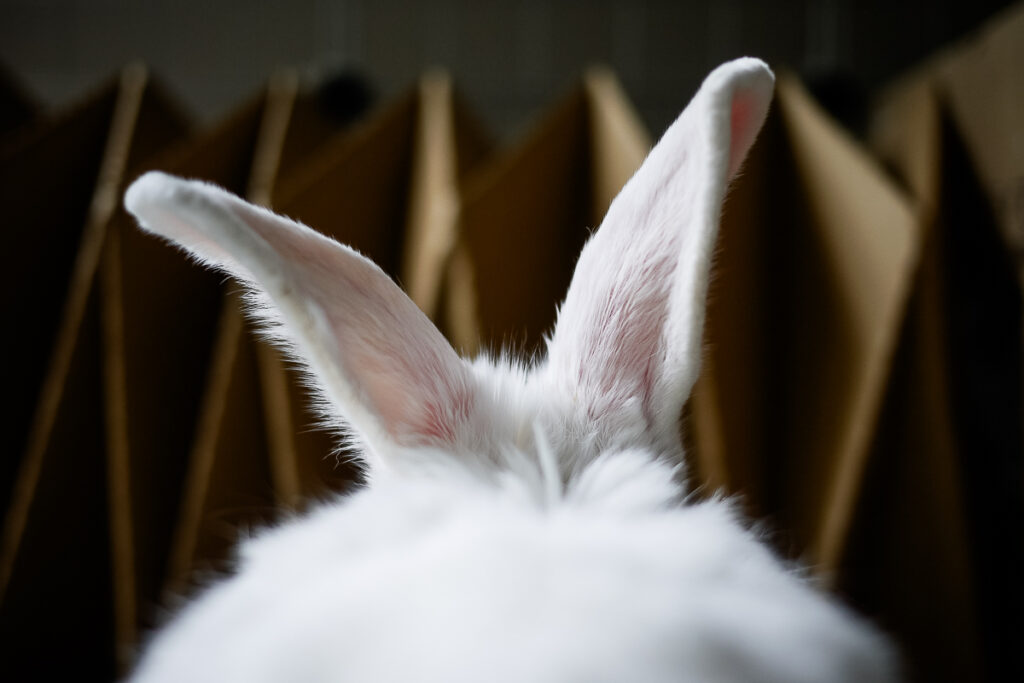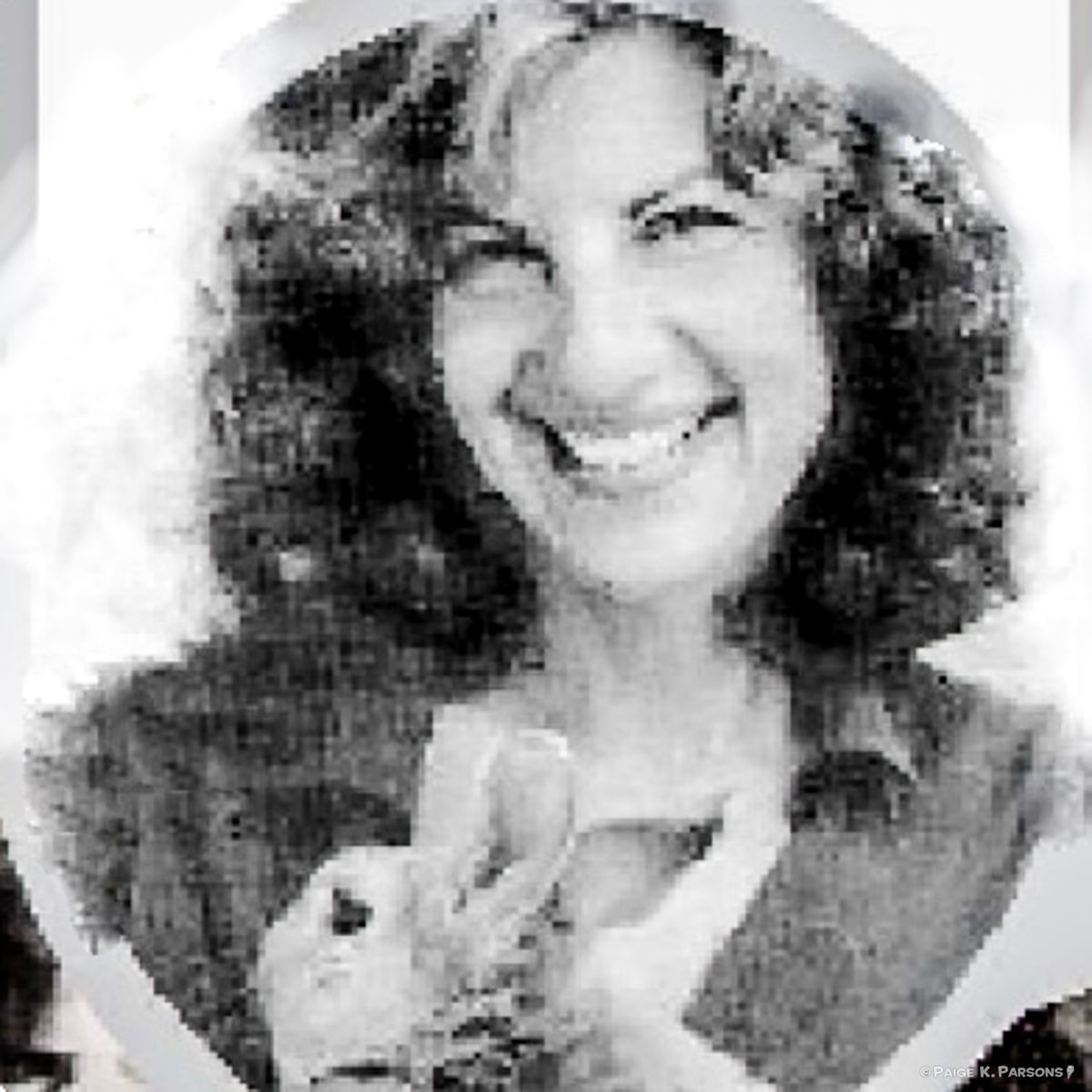When asked to name the first three things that came to mind about rabbits, in an extremely unscientific sample of 20, 100% of respondents mentioned ears. Along with twitching nose and fluffy tail, the ears make the bun. Those of us fortunate enough to live with rabbits know firsthand the eloquence of the ear. Not a mere aural-intake device but also a finely tuned communication station, ears tell us almost as much about the creature beneath them as they tell her about her immediate environment.
THE EXPRESSIVE EAR
Our species, with fungoid lumps of cartilage clamped inelegantly to the side of the head and (if we’re lucky) concealed by hair, can only envy the rabbit her silky ears and their ability to convey complex messages with a flick of the instrument. Rabbit ears, like the t.v. antenna they inspired, can go up in very fine gradations and independent directions. They can swivel, radar-like, also independently. And although rabbits can not literally vary ear-width, they can approximate it by adjusting ear direction and verticality, in effect controlling the visibility of shell-like inner surface of ear.
Because ears are so mobile, they provide a detailed glossary of mood and interest. Even lops with very limited ear control (see sidebar) can impart a wealth of information, especially when combined with body position and movement. Each rabbit, and each human-rabbit pair (or, preferably, human-rabbit-rabbit trio), develops a unique lexicon. Friendship deepens as you compile your own personal dictionary.
Start, as on a pair of dials, with both ears down/back. This can signal anger, if the tail is up and the situation warrants; or utter relaxation, if accompanied by relaxed position and, often, the twitching eyelids of REM dreamtime. In this instance, Thumper is sitting quietly, not sacked out with legs extended behind, but a neat bun in breadloaf position.
One ear comes up fractionally, and that fraction expresses the percentage of interest. As we observe the ear’s trajectory, we see the direction of the potentially interesting event. At 25 degrees, the ear rests for a few moments, then returns to join its partner across the back. Potential distraction dismissed. Dreamtime resumed. Both ears down, then both coming up, more quickly than not, swivelling in the direction of the kitchen, down a long hallway, where a refrigerator door is being opened. We raise our head, and the ear nearest us points our way: “Food. For me? Yes!”
Both ears at ultimate vertical, pointing the same direction, “wide open” in the sense that much pink is visible: “Something interesting (and not at all frightening) is definitely happening. For this I might even stand up.” Both ears up, one pointing forward, one to the side or back. When ears point in different directions, context will reveal whether this signals ambivalence about a single stimulus-one ear pointing toward source of interest, the other monitoring escape options or going into early aggressive mode-or the presence of multiple stimuli.
Loose-limbed head-shaking ear waggle: Yee-haw! It’s national Silly Rabbit Day, and festivities have just begun. Stay tuned for Dancing, Leaping, Dancing-and-Simultaneous-Leaping, and Shake-Rattle-and-Rollin’.
DIRECTION MATTERS
As prey animals, wild rabbits are designed to take in and react quickly to a great deal of information about their immediate environment. The eyes are placed well to the sides of the head, maximizing peripheral vision. The ears, large and impressively mobile, funnel sound to the brain for instant feedback. Lop ears may be adorable by human standards, but like the overlarge head and shortened muzzle of the bulldog, Mother Nature was wise to omit them. They may block vision and are more inviting to parasites. Rabbits, naturallly intelligent and creative, make the best of these encumbrances; lops are remarkably articulate, and the “airplane ear” lop-mixes even more so.
SOUND, FURY, AND SIGNIFYING
Whoever said rabbits are quiet never shared a home with one. Rabbits’ capacity for and apparent pleasure in noise-making brings fresh admiration of their ingenuity and playfulness.
HRS educator Julie Smith poses interesting questions about intent and the effects of domestication: “I dropped a huge ceramic crock filled with water. It crashed to the floor, but Hattie and Arlo, the two rabbits in the room, didn’t flinch-they just looked interested. I filled another crock and put it on the shelf while I picked up a shard I had missed. Hattie ran up the ramp to the shelf and pushed off the second crock, which made a huge noise. I got the distinct impression that she was thinking, ‘At last! You’ve finally done something interesting.’ She seemed to be inviting me to play this new game, to drop yet another crock in response to her throwing down one.
“This experience made me wonder if rabbits seek to make noise or just make it in the process of pushing things around. And if they make little noise in nature, do they come to take a learned pleasure from the noise they can make in human environments?”
Californians know what Carole King meant when she sang of feeling the earth move under her feet. Long-time [rabbit rescuer and educator] Holly O’Meara writes, “I had an elderly rabbit, Charlotte, loose in my kitchen during the 1994 Northridge earthquake. I found her hopping around the broken glass and china on the floor, looking interested. None of my rabbits seemed upset by the flying and crashing objects, including an entire bookcase that tipped over. However, a few weeks later, the rabbits jumped when a string holding my Christmas cards fell down, sending the cards fluttering to the floor.”
Holly also writes: “This morning I glanced at Paul Rabbit and said, ‘Are you OK?’ cuz his ears were down. He flicked his ears forward and went back to eating. I relaxed. I rely a lot on ear position to assess health.” Sound bites and other lessons:
Like humans, deaf rabbits become adept at filling in the blank spots with input from other senses. In addition, “selective deafness” (also present in adolescent humans) can fool us, as in the rabbit who hears the sound of a cereal box being removed from the cupboard three rooms away but does not hear “Not on my pillow!” loudly implored from three feet away.
“Bogart was a huge French lop who bit first and asked questions later,” says [rabbit] educator and fosterer Susan Smith. “He was hard of hearing, and his upper vision was blocked by the heavy brows, fur, and ears inflicted on this breed. We learned to approach him from the low side and always announced our presence loudly. In time, he mellowed and learned to trust, and the biting issue disappeared. We learned from Bogart that it’s always a good idea to test vision and hearing in biters.”
©Copyright Amy Espie. All Rights Reserved. Republished with the permission of the author.
The Eloquent Ear: An Aural Celebration was originally published in House Rabbit Journal Volume IV, Number 11

